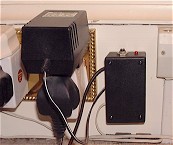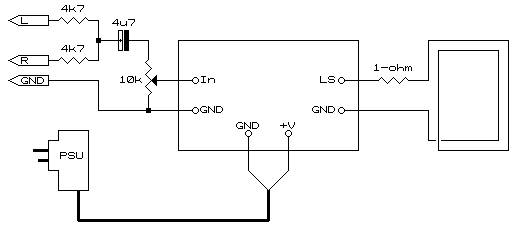|
"When one's eyesight goes, The above comment was sent as the opening line in an email of someone who has implemented this loop. What really made me chuckle was he has connected this to a radio and manages to listen to it all day long without another soul knowing anything about it! Deaf is not a sign of stupidity; Far from it! Hearing aid loops (also known as 'deaf aid loops') need not break the bank! Here is a cost effective way to beat the 'Loud TV Blues'! Before we start. Being of perfect hearing, I cannot justify getting a hearing aid. If there is a manufacturer of hearing aids that would like to contribute one for my experimental use, then I would be most grateful if you would contact me. The story began when visiting a dear relative in the UK whose house mate is hearing impaired. The basic problem was a simple one, my relative has sensitive hearing and therefore has the TV at about volume level 2 but his pal required the TV at about 4 in order to start hhearing properly, this while he had his hearing aid in! What the basic problem is is that the microphone of the hearing aid is sensitive to ALL sounds (including noises) and therefore the only way to increase the 'signal to noise' ratio is to turn up the TV..... resulting in frayed nerves. The cure was simple, a hearing aid loop. The principle of this is to use a facility on all hearing aids called the 'T' setting, the 't' meaning 'telephone'. What this does is to switch the input of the hearing aid to a little coil inside the hearing aid that then picks up the changing magnetic field of the telephone earpiece thus removing the need for the earpiece to feed the microphone with sufficient sound. This coil is also available to other 'magnetic' fields if they are created properly. This is where the hearing aid loop comes into it's own. What is done is to feed a signal into a loop that is deliberately made as large as the area requiring to be covered (usually the TV room). We priced typical units and the prices hovered around £100+. My first attempt was to prove that what was required was easily achieved and used a 'sound blaster' speaker kit but replaced the speaker (the one that could unplug) with a loop under the lounge carpet. Hey presto, the theory was proved, that little 'black box' was nothing more than a simple amplifier. This is where so many people have made hundreds of Pounds in ripping the hearing handicapped off! The next step was to obtain a simple amplifier and used the most expensive route one could take but with time being a constraint I had to settle for using kits! Using a '7-watt amplifier kit' (which had to still be assembled!), a pre-built 'battery eliminator' style power supply, and housing the amp in a small plastic box (this screwed down to the skirting board) a loop 'unit' was built for under £30.
This has one criteria, it must have sufficient resistance so as not to load the amp and cause it destruction. I.T.C. (indoor telephone cable) has a resistance of about 10Ω per 100 meters of conductor. I was privy to a 4 pair (thus 8 wires) cable and needing a loop of 4 by 4 metres gave me 4 X 4 X 8 = 128 metres of wire, this brought me to about 12Ω, well above the problem impedance of the amplifier. Now for another little trick. One must remember that we have created a loop and therefore an inductor and this could cause a bit of instability in the amplifier but an addition of a 1Ω resistor in series with the loop cures this.
Any amplifier can be used including an old 'public address' type or an old hi-fi that has been discarded because it does not 'perform' to the deafening standards of now-a-days (the old stereo allows for two seperate loops to be had within e.g. the lounge and dining-room, however, do not be tempted to make both amplifiers feed one loop or two loops above one another, that's asking for trouble!).
Let's first investigate the DIY kit. All the specified parts are supplied (hopefully). Then there is a convenient circuit board to mount them on. Miscellaneous parts like heatsinks are usually supplied too. All this at a usually reasonable price. Oh, and as a bonus, they throw in assembling instructions. A highly suitable one is the Velleman kit No. K4001 - Maplin's part number VF55, priced at £9.99 (info correct as at June 2001). If the thrill of building the amplifier is not quite up your street, then Maplin offers an even cheaper option! Product code N08AA, price £7.99 comes ready assembled. Also, if you subscribe to the monthly Maplin newsletter you get 'money off' vouchers every month with one offering a whole £2 off any purchase over £5 giving one a suitable amp for £5.99! The power supply is nothing more than a "DC adapter". Do make sure to get one that will supply both the voltage and current required. As a good rule when supplying low-power audio amplifiers is to ensure the power supply is capable of supplying about 1.5 times the power of the output of the amp (power = volts x current). I would personally get one capable of 12V @ 0.8A. It does not need to be a regulated type, and saves quite a bit on the price.
The part they won't tell you in the assembly instructions is how to wire the amp up to the hi-fi or TV. Below is a typical circuit. Please note that the connections to the PC board are only indicative and any similarity to any kit is purely coincidental. Most modern TVs have an output on the rear (either Hi-Fi type sockets or a SCART connector) and the audio on these is normally isolated through transformers (again, it would be prudent to check).
As most modern equipment is stereo we have shown a method by which the stereo to mono conversion should be done using two 4k7, ¼W resistors. It is not correct to simply short the left and right channels as this could lead to the two outputs "working against each other" and, depending on the design, damage the circuitry. The now available mono signal is fed to the loop amplifier. The capacitor ahead of the variable potentiometer is simply to decouple any possible DC that may exist on the output of the TV sockets. Although such DC is highly unlikely, it is still recommended. The best is a non-polarised type of about 63 to 100V, but may be a small electrolytic of no less than 25V and then installed with the positive towards the TV. Output stability is achieved using a 1Ω, 2W, carbon or metal-film resistor (not wire-wound!). If you cannot get a carbon or film resistor that can handle 2 watts, then try a 1W resistor as there is little power wasted in this resistor, but it will get warmer than the 2W. Please note: Make absolutely sure this resistor is fully suspended in free air. Please do not wrap it in something and hide it under the carpet! I have deliberately not gone into a lot of technical detail here as the purpose of this was more to point you in the direction of a cost effective solution to a hearing aid loop. I don't know what it is like to be hard of hearing or deaf as I have superb hearing with the ability to hear frequencies beyond 25kHz, but when I saw a grown man with tears in his eyes because he could hear made the few hours effort more than worth while.
One chap asked me if a microphone could be attached to his unit. A microphone was duly added. I then get an upsetting call from his wife. It transpired he would deliberately leave the living room to listen what his wife said about him to friends. It proves that being hard of hearing doesn't mean the crafty side is hard of working! I will willingly answer any queries anyone has in creating their own loops from the 'electronic junk' lying about, just pop a message in my mailbox.
© 27.08.01 / 15.06.07 |
 Although it would take very little to post a circuit here for the DIY enthusiast, the problem comes when trying to obtain the relevant parts from your local electronics DIY store. Visiting Maplin's reveals a number of audio amplifier kits available, at very affordable prices, and made me re-think the validity of even worrying about designing one.
Although it would take very little to post a circuit here for the DIY enthusiast, the problem comes when trying to obtain the relevant parts from your local electronics DIY store. Visiting Maplin's reveals a number of audio amplifier kits available, at very affordable prices, and made me re-think the validity of even worrying about designing one.